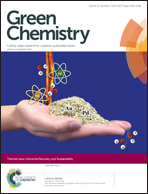Effect of torrefaction on biomass structure and hydrocarbon production from fast pyrolysis†
Abstract
Torrefaction has been shown to improve the chemical composition of bio-oils produced from fast pyrolysis by lowering its oxygen content and enhancing the aromatic yield. A Py-GC/MS study was employed to investigate the effect of torrefaction temperatures (225, 250 and 275 °C) and residence times (15, 30 and 45 min) on product distribution from non-catalytic and H+ZSM-5 catalyzed pyrolysis of pinewood. During torrefaction, structural transformations in biomass constitutive polymers: hemicellulose, cellulose and lignin took place, which were evaluated using component analysis, solid state CP/MAS 13C NMR and XRD techniques. Torrefaction caused deacetylation and decomposition of hemicellulose, cleavage of aryl ether linkages and demethoxylation of lignin, degradation of cellulose and an overall increase in aromaticity of biomass, all of which affected the product yield from pyrolysis of torrefied biomass. For non-catalytic pyrolysis, selectivity of phenolic compounds increased with an increase in torrefaction severity while that of furan compounds decreased. In the case of catalytic pyrolysis, the sample torrefied at 225 °C-30 min and 250 °C-15 min resulted in a significant increase in aromatic hydrocarbon (HC) and also total carbon yield (approx. 1.6 times higher) as compared to catalytic pyrolysis of non-torrefied pine. Cleavage of aryl ether linkages and demethoxylation in lignin due to torrefaction caused increased yield of phenolic compounds, which in the presence of a catalyst were dehydrated to form aromatic HC.


 Please wait while we load your content...
Please wait while we load your content...